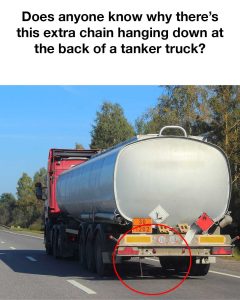role in the safe transportation of liquid and gaseous materials, such as fuel, water, chemicals, and consumable liquids. These vehicles are specially engineered to carry substances that require strict containment due to their potential risks. Designed with cylindrical tanks mounted on strong chassis frames, tanker trucks are built to ensure the safe and efficient movement of their contents. While most people notice the large tanks and powerful structure of these trucks, few pay attention to a small but critical detail—a metal chain that hangs from the back of the vehicle. This chain, though simple in appearance, serves an incredibly important safety function and reflects decades of innovation in the transportation of hazardous materials.

The purpose of this hanging chain is to act as a grounding device. When tanker trucks transport flammable liquids like gasoline or diesel, friction between the liquid and the tank can create static electricity. Additionally, the movement of the truck over long distances contributes to this electrical buildup. If left unmanaged, this static charge can result in a spark, which poses a dangerous fire or explosion risk—especially when dealing with highly flammable materials. The chain trailing behind the truck maintains contact with the ground, offering a pathway for the static charge to discharge safely into the earth. By doing so, it dramatically reduces the chances of a potentially catastrophic event.
Historically, grounding chains became a standard feature on tanker trucks as industries began to understand the risks posed by static electricity. In the early years of fuel transport, the lack of grounding solutions contributed to accidents involving sparks igniting flammable vapors. These incidents led to injuries, fatalities, and massive property damage. As awareness grew, regulations were introduced to make fuel transport safer. Grounding chains proved to be one of the simplest and most effective solutions, becoming an industry norm. Their continued use today is supported by safety protocols and government regulations around the world, emphasizing their importance.
In the United States, the Department of Transportation (DOT) oversees regulations concerning the safe operation of tanker trucks. These rules cover everything from how tanks are constructed to how pressure is regulated—and, importantly, how static electricity is controlled. The grounding chain is part of a broader system of safety features required by law. Inspections of tanker trucks often include checks to ensure that the grounding chain is intact, properly attached, and functional. If it’s missing or damaged, the truck could fail inspection and be taken out of service until the issue is fixed. These measures help protect not only the driver but also the general public from accidents that could otherwise be avoided.
Understanding the science behind static electricity gives further insight into why this chain is so important. Static electricity arises when two materials come into contact and then separate, leaving an imbalance of electrons. This imbalance creates a static charge, which seeks a pathway to neutralize itself. In the case of fuel transport, the liquid moving around inside the metal tank creates just such a scenario. When vapors from flammable liquids are present, even a small discharge of electricity can trigger ignition. The grounding chain acts as that neutralizing path, discharging the static buildup harmlessly into the ground.
Though grounding chains are commonly used, they are not the only solution available today. Some modern tanker trucks now use retractable static grounding reels, which can be manually attached to a grounding point during fuel loading or unloading. This method ensures a solid electrical connection with the earth. Additionally, certain anti-static additives can be mixed with fuels to reduce the likelihood of static buildup during transport. Technological advancements have also led to the development of special coatings and materials for tanks and pipelines that help minimize friction and the resulting electrical charge. These solutions are often used alongside grounding chains to create a multi-layered approach to safety.
Despite the presence of new technologies, some misconceptions about the grounding chain persist. One common myth is that the chain is just a leftover part with no functional use, or that it helps stabilize the truck during movement. Others assume that the chain is an outdated relic and unnecessary in today’s high-tech world. In reality, the chain remains a vital safety feature due to its reliability and simplicity. Even with the latest safety systems in place, the grounding chain continues to provide a critical line of defense against static-related accidents.
This seemingly small detail plays a major role in accident prevention. Fires and explosions caused by static discharge can be devastating, especially when they involve fuel or other hazardous liquids. The grounding chain helps eliminate one of the primary triggers of such disasters by keeping static electricity at bay. It’s a reminder that sometimes, the simplest tools are also the most effective. For drivers and logistics personnel, knowing that this chain is working properly offers peace of mind during long hauls and daily operations.
However, to be effective, the grounding chain must be properly maintained. Like any other component on a truck, it is subject to wear and tear. Over time, the chain can rust, break, or lose proper contact with the ground. If it’s too short or not hanging low enough, it won’t serve its purpose. That’s why it’s essential to inspect the chain regularly and replace it if there are signs of damage. Maintenance teams are trained to check the chain’s condition during standard vehicle inspections. Ensuring that the chain makes consistent contact with the ground is key to its performance, and neglecting this can lead to safety lapses.
In summary, the dangling chain at the rear of a tanker truck is far more than just a piece of hanging metal. It is an important component of a broader safety system designed to prevent accidents involving static electricity and flammable materials. By allowing static charges to safely discharge into the earth, the grounding chain minimizes the risk of ignition during transport. Supported by decades of use, industry regulations, and scientific understanding, this chain represents a simple but essential safety measure. Maintaining and respecting its role in fuel transport is critical for ensuring the safety of truck operators, infrastructure, and the public at large.





